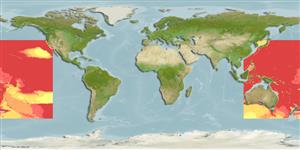>
Myctophiformes (Lanternfishes) >
Myctophidae (Lanternfishes) > Myctophinae
Etymology: Myctophum: Greek, mykter, -eros = nose + Greek, ophis = serpent (Ref. 45335).
More on author: Garman.
Environment: milieu / climate zone / depth range / distribution range
Écologie
marin bathypélagique; océanodrome (Ref. 51243); profondeur 412 - 1537 m (Ref. 27311). Deep-water; 42°N - 52°S, 112°E - 117°W
Circumglobal (Ref. 7300) in all tropical and subtropical waters (Ref. 47377). Eastern Atlantic: Morocco to South Africa (as expatriates in Agulhas water pockets). Western Atlantic: between about 42°N and 34°S. Indian Ocean: between 7°N and 24°S. Pacific Ocean: between 32°N and 31°S, but extends northward to 40°N in the Kuroshio Current. South China Sea (Ref.74511).
Length at first maturity / Taille / Poids / Âge
Maturity: Lm ?, range 6 - ? cm
Max length : 8.3 cm SL mâle / non sexé; (Ref. 4479)
Épines dorsales (Total): 0; Rayons mous dorsaux (Total): 12-14; Épines anales 0; Rayons mous anaux: 18 - 21; Vertèbres: 36 - 39. Branchiostegal rays: 9-10 (Ref. 31442). Anal organs 14; male supracaudal gland has 5-8, female infracaudal gland with 2-6 small, round to oblong spots, respectively; may be distinguished from all other Myctophum possessing cycloid scales by its angulate, non-serrate, posterodorsal margin of the operculum (Ref. 39633).
High-oceanic, nyctoepipelagic at the surface and to 950 m and generally found between 475-850 m during the day (Ref. 4479). Neustonic to mesopelagic (Ref. 58302). Oviparous, with planktonic eggs and larvae (Ref. 31442). Lipid content is 3.8 % in fresh body weight and wax ester is 10.6 % in total lipids (Ref. 9193). Females reach sexual maturity at 4.8 cm, males at 3.5 cm (Ref. 47377).
Hulley, P.A., 1990. Myctophidae. p. 398-467. In J.C. Quero, J.C. Hureau, C. Karrer, A. Post and L. Saldanha (eds.) Check-list of the fishes of the eastern tropical Atlantic (CLOFETA). JNICT, Lisbon; SEI; Paris; and UNESCO, Paris. Vol. 1. (Ref. 4479)
Statut dans la liste rouge de l'IUCN (Ref. 130435)
Menace pour l'homme
Harmless
Utilisations par l'homme
Outils
Articles particuliers
Télécharger en XML
Sources Internet
Estimates based on models
Preferred temperature (Ref.
123201): 4.2 - 8.7, mean 6.2 °C (based on 536 cells).
Phylogenetic diversity index (Ref.
82804): PD
50 = 0.5000 [Uniqueness, from 0.5 = low to 2.0 = high].
Bayesian length-weight: a=0.00912 (0.00476 - 0.01747), b=3.12 (2.95 - 3.29), in cm total length, based on LWR estimates for this species & (Sub)family-body (Ref.
93245).
Niveau trophique (Ref.
69278): 3.4 ±0.45 se; based on food items.
Generation time: 2.6 ( na - na) years. Estimated as median ln(3)/K based on 1
growth studies.
Résilience (Ref.
120179): Milieu, temps minimum de doublement de population : 1,4 à 4,4 années (K=0.42; tm=3).
Fishing Vulnerability (Ref.
59153): Low to moderate vulnerability (28 of 100).
